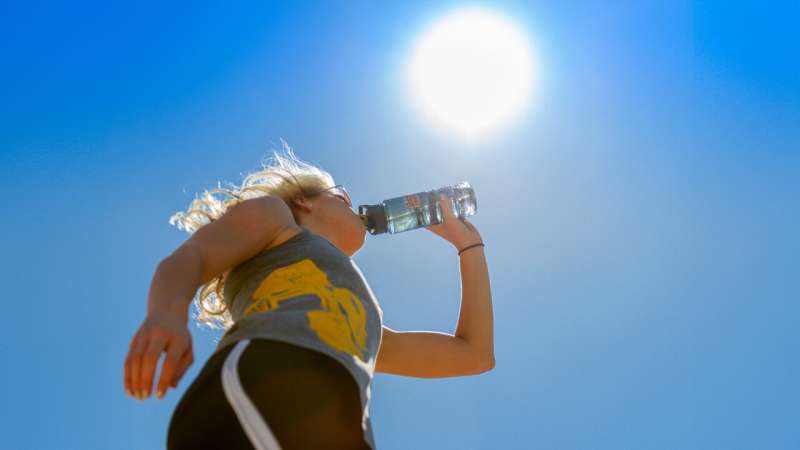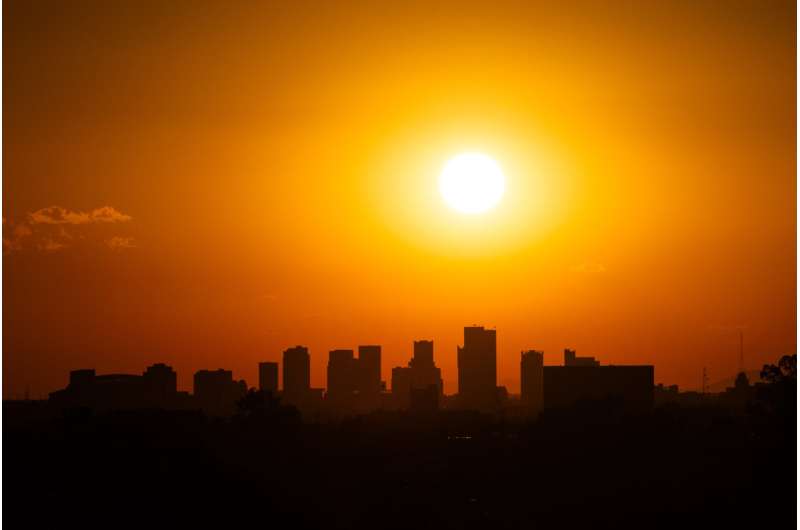Air temperature survival limits are significantly reduced in humid heat, and even more so for older people. The corresponding wet temperatures in dry weather are considerably lower than the previously assumed limit of 95F or 35C. A humid temperature of just 78 F on a dry summer day in Phoenix would be considered insurmountable, but it would take an air temperature of 128 F under 10% relative humidity to reach that limit. Credit: ASU Global Futures Laboratory
Typically associated with longer days and slower paces, this summer’s record heat in Arizona demonstrated an ominous future for the planet’s hottest season. With power outages endangering entire neighborhoods and heat-related deaths increasing among some of the state’s most vulnerable populations, the city of Phoenix found itself in national headlines. As national attention grew, one question became clear: How can anyone live there?
The consequences of extreme heat don’t just affect Arizona residents. Extreme heat has made global news this year, notably in November when a 23-year-old woman died of cardiorespiratory arrest at a Taylor Swift concert in Brazil, where the heat index exceeded that day- there 120 degrees.
Jennifer Vanos, an associate professor in the School of Sustainability at Arizona State University, studies extreme heat and its health impacts. She is the lead author of a new article published November 29 in Natural communications.
Titled “A physiological approach to assessing human survivability and the ability to live in heat in a changing climate,” the paper explores the temperatures humans can survive. Research demonstrates that the estimated upper limits of temperature and humidity currently used for human survival may not provide an accurate picture of the impacts of global warming on human health.
“For the last decade or so, we’ve been using what we call a ‘wet temperature’ of 35 degrees Celsius, or 95 degrees Fahrenheit, as the limit for human survival,” said Vanos, also a senior researcher on global futures at Julie . Ann Wrigley Global Futures Lab.

Extreme heat is becoming increasingly dangerous for many people around the world. In this new study published in Natural communications, an interdisciplinary research team studies extreme heat and the types of conditions in which people can survive, as well as the conditions that will allow them to actually live their lives. Credit: Arizona State University
The wet bulb temperature limit for human survival indicates the maximum combinations of temperature and humidity that humans can tolerate without suffering unavoidable heat stroke over a specified duration of exposure.
“The idea is that you could survive up to six hours at that level of heat exposure,” Vanos said. “This figure oversimplifies what happens physiologically in the body when it is exposed to this temperature, and it does not take into account important variables like age or other vulnerability factors.”
Vanos said the wet bulb temperature commonly used for human survival assumes the person is indoors or in the shade, undressed, completely sedentary, fully acclimated to the heat and of “average size.” These assumptions do not correspond, in most cases, to how humanity deals with the summer season. The paper models scenarios that take into account factors such as humidity, age, activity level and sun exposure, and proposes a safe temperature range based on a series of characteristics.
“We didn’t just want to better understand the conditions in which people could survive,” Vanos said. “We wanted to understand the conditions that allowed people to live their lives. If the only safe way to live in a neighborhood is to be completely sedentary, people are not going to want to live there. Being able to spend time outside and live your life without Seeing a sustained increase in core temperature is a very important metric to understand today and as we move into the future.”

Downtown Phoenix, Arizona: The effects of extreme heat aren’t just affecting Arizona residents. Extreme heat is making global news this year. Credit: Andy DeLisle/Arizona State University
Vanos said Gisel Guzman Echavarria, an ASU student, was instrumental in creating the figures used throughout the paper to demonstrate the research findings.
The research was conducted by a combination of climate scientists and physiologists, a collaboration that Vanos said was crucial to understanding the intertwined nature of heat and human health. Ollie Jay, professor and director of the Heat and Health Research Incubator at the University of Sydney, said the combined perspectives allow for a coherent understanding of exactly how climate outcomes can impact people. at the physiological and biophysical levels.
“The current wet-bulb temperature estimate of 35 degrees Celsius is used very commonly, one example being the Intergovernmental Panel on Climate Change report,” said Jay, lead author of the paper. “These kinds of reports can shape policy efforts, but they use a heat model that is a very conservative estimate of the impacts on humans. If we start using a more realistic, human-based model, the impacts “will be more serious. They’re going to be more widespread and they’re going to happen sooner than expected. ”
Vanos and Jay agree that the survivability ranges provided in the document can provide important insight into the future: a future that includes an increased need for cooling infrastructure, a personalized approach to thermal protection, and possible migration due in the heat.
“One of the most important things I hope people understand from these results is that the conditions that allow someone who is a very healthy young adult to survive can be experienced very differently by someone who has a comorbidity or is taking prescription medications,” Vanos said. . “As we move forward through extreme heat, we must give people the tools they need to survive these insurmountable days.”
More information:
Jennifer Vanos et al, A physiological approach to assessing human survivability and heat habitability in a changing climate, Natural communications (2023). DOI: 10.1038/s41467-023-43121-5
Provided by Arizona State University
Quote: New research explores future limits of survival and habitability in extreme heat (November 30, 2023) retrieved December 1, 2023 from
This document is subject to copyright. Except for fair use for private study or research purposes, no part may be reproduced without written permission. The content is provided for information only.



